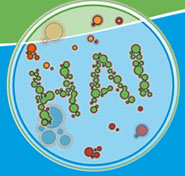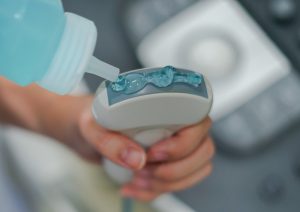Reduce the Spread of Infection in Ultrasound

Medical facilities exist to care for and improve the health of their patients. However, a major concern for patients is the risk of getting an infection during a procedure or hospital stay. Healthcare-associated infections (HAIs) are acquired while patients receive health care for another condition1 and can occur 48 to 72 hours after treatment.2
 Approximately 1 in 31 U.S. patients has at least one infection in association with his or her hospital care, underscoring the need for improvements in patient care practices in U.S. healthcare facilities.3 In 2015, The Centers for Disease Control and Prevention (CDC) reported 687,000 patients with HAIs. Of those, 72,000 patients died while hospitalized.4
Approximately 1 in 31 U.S. patients has at least one infection in association with his or her hospital care, underscoring the need for improvements in patient care practices in U.S. healthcare facilities.3 In 2015, The Centers for Disease Control and Prevention (CDC) reported 687,000 patients with HAIs. Of those, 72,000 patients died while hospitalized.4
Healthcare-associated infections cost tens of thousands of lives a year, and many of them are preventable. Additionally, HAIs are increasingly harder to treat as antibiotic drug resistance becomes more prevalent. A CDC report shows 2.8 million people are sickened each year in the United States from pathogens that have learned to outsmart antimicrobial drugs, an increase of 800,000 per year since the previous report was issued in 2013.5
"A lot of progress has been made, but the bottom line is that antimicrobial resistance is worse than we previously thought," said Michael Craig, the senior adviser on antibiotic resistance for the Centers for Disease Control and Prevention. "Every 11 seconds someone in the United States gets a resistant infection and someone dies every 15 minutes."5
What causes healthcare-associated infections?
 HAIs can be caused by bacteria, fungi, viruses, or other less common pathogens. Contamination can be caused by bacteria from a variety of sources common in a hospital or procedural setting, including:
HAIs can be caused by bacteria, fungi, viruses, or other less common pathogens. Contamination can be caused by bacteria from a variety of sources common in a hospital or procedural setting, including:
- Hands
- Ultrasound transducers
- Examination tables
- Ultrasound systems
- Door handles
- Ultrasound gel6
A blinded study demonstrated just how easily bacteria can spread around an ultrasound exam room. The researchers placed glow powder in several locations of the ultrasound suite and investigated primary (ultrasound system monitor, gel bottle, disinfecting spray bottle, etc.) and secondary (other transducers, transducer cables, etc.) surfaces after exam clean-up.
The result? The gel bottle was the most frequently contaminated item.9
The external surface of a reusable gel bottle can be a source of bacteria, but ultrasound gel itself can also be a source of contamination.
Can ultrasound gel lead to infections?

Yes. Most ultrasound gel is composed of propylene glycol and water and is bacteriostatic, meaning that it can inhibit the growth or reproduction of bacteria.8 When contaminated ultrasound gel enters a patient's bloodstream during an ultrasound-guided intervention, it presents a risk for infection.
Published studies have outlined multiple cases of infection due to the use of contaminated ultrasound gel. Below are examples of recent cases:
Outbreak of health care associated Burkholderia cenocepacia bacteremia and infection attributed to contaminated sterile gel used for central line insertion under ultrasound guidance and other procedures, The American Journal of Infection Control7
A 2017 outbreak of Burkholderia cenocepacia bacteremia across four hospitals in Australia infected 11 patients, primarily in intensive care units. Cultures from the affected patients were tested to determine the source of the infection - contaminated single-use sterile ultrasound gel from procedure kits used in central line placements and other procedures. The gel was found to be heavily contaminated with Burkholderia cenocepacia. Each of the patients had undergone an ultrasound-guided intervention.
Outbreak of Burkholderia cepacia bacteraemia in a tertiary care centre due to contaminated ultrasound probe gel, Journal of Hospital Infection10
Two people died of septic shock after B. cepacia was found in the blood cultures of 14 patients at a Saudi Arabian hospital in 2016. All patients had central venous catheters placed. Multiple cultures were tested, and ultrasound gel sachets used in the procedures were identified as the source of the infections.
From the authors: "Products that are supposed to be sterile may become contaminated during the manufacturing process, leading to infections. Invasive procedures put patients at higher risk for infection, particularly immunocompromised ICU patients."
Polyclonal outbreak of bacteremia caused by Burkholderia cepacia complex and the presumptive role of ultrasound gel, The Brazilian Journal of Infectious Diseases13
The 2013 outbreak of Burkholderia cepacian complex (BCC) in Argentina affected 11 patients who had undergone an average of five ultrasound procedures or examinations in the neonatal, intensive care, and general medical units. Samples were cultured from a variety of sources, including antiseptics, drugs, surgical room surfaces, and ultrasound gel. "BCC stains were isolated only from ultrasound scanning gels," - an unopened five-liter container of ultrasound gel.
Pseudomonas aeruginosa respiratory tract infections associated with contaminated ultrasound gel used for transesophageal echocardiography, Centers for Disease Control & Prevention (CDC)14
In 2011, seven patients were infected and nine were colonized with P. aeruginosa following cardiovascular surgery with the use of transesophageal echocardiography. After the Michigan facility noticed the increase of positive respiratory cultures in the ICU, an investigation found the source to be contaminated ultrasound gel. Cultures were found in both opened and unopened multiuse gel bottles.
How should ultrasound gel be managed?
- Determine if ultrasound gel is necessary for the procedure or examination
- Gel-free viral barriers now exist for ultrasound
- Envision probe covers and scanning pads are activated with sterile liquid and require no ultrasound gel. Cover the ultrasound probe or apply the scanning pad directly to the patient's skin for safe scanning without gel.
- Reduces the risk of contamination during CVC or PICC line placements, scanning of wounds or non-intact skin, intraoperative imaging procedures, and other interventions
- Workflow also improves - no gel results in quick set-up and clean-up of the transducer
- If the use of gel is necessary, consider recommendations to minimize infection risk
- AIUM11:
- Discard and replace multidose containers when empty; these should not be refilled;
- Appropriately seal the containers when not in use; and
- Avoid direct contact between the gel container dispensing tip and any persons or instrumentation, including the ultrasound transducer.
- AIUM11:
-
- Health Canada12:
- Establish guidelines on the use of ultrasound gel at your facility
- Consider using single-dose, sterile gels
How to reduce the spread of infection in ultrasound
- Cover the ultrasound probe with a validated viral barrier. Probe covers inhibit the transfer of pathogens through probe contamination.
- Use of probe sheaths that have been designed, validated, and FDA-cleared for use as an ultrasound probe cover.
- Though used by some as probe covers, condoms and bandages, such as Tegaderm‚Ñ¢ and Opsite‚Ñ¢, have not been validated as probe covers, and are not FDA-cleared for use as probe covers.
- When ultrasound gel must be utilized, use sterile, single-use packets, and remove it from the site prior to puncture
- Cover the ultrasound system with a sterile drape15
- Properly clean and reprocess the ultrasound transducer between patients
- Guidelines vary - check with your facility's infection control department, as well as with the ultrasound device manufacturer.
Increased awareness and improved policies and practices are needed to fight the spread of healthcare-associated infections. Recent signs of progress indicate that current measures are helping.
In 2018, U.S. hospitals observed 8 to 12% fewer central line bloodstream infections, catheter-associated urinary tract infections, and C difficile infections compared to the 2017 national baseline.4
This is promising, and with continued research and education, investments in innovative products and solutions, and improved procedures and processes, we can achieve safer health outcomes for clinicians and patients.
References
- "Health Care-Associated Infections - HHS.Gov." HHS.Gov, Sept. 2, 2021 https://www.hhs.gov/oidp/topics/health-care-associated-infections/index.html#:~:text=Healthcare%2Dassociated%20infections%20(HAIs),and%20long%2Dterm%20care%20facilities,
- Monegro, Alberto. "Hospital Acquired Infections." Stat Pearls, Jan. 2022. https://www.ncbi.nlm.nih.gov/books/NBK441857/
- C, Peter. "Management of Health-Care-Associated Infections in the Oncology Patient." Cancer Network, vol. 17, no. 3, Mar. 2003, www.cancernetwork.com/cancer-complications/management-healthcare associated-infections-oncology-patient, https://www.cancernetwork.com/node/422842.
- "Current HAI Progress Report." Cdc.Gov, 2019,https://www.cdc.gov/hai/data/portal/index.html
- "Data Portal." Cdc.Gov, 2020, www.cdc.gov/hai/data/portal/index.html. Accessed 30 Jan. 2020.
- Richtel, Matt, and Andrew Jacobs. "New York Identifies Hospitals and Nursing Homes With Deadly Fungus." New York Times, 14 Nov. 2019, www.nytimes.com/2019/11/13/health/candida-auris-resistanthospitals.html.
- Westerway S, Basseal J, Brockway, Hyett A, Carter D. "Potential Infection Control Risks Associated With Ultrasound Equipment - A Bacterial Perspective" Ultrasound in Med & Biol., Vol 43, No 2, 421-426 2017.
- Shaban R, et al "Outbreak of health care-associated Burkholderia cenocepacia bacteremia and infection attributed to contaminated sterile gel used for central line insertion under ultrasound guidance and other procedures" American Journal of Infection Control 45 (2017) 954-8.
- Shiel, William C. "Medical Definition of Bacteriostatic." MedicineNet, MedicineNet, 11 Dec. 2018, www.medicinenet.com/script/main/art.asp?articlekey=20600.
- Pessin, Y. J., & Matthews, E. P. (2019). Glow Powder: See the Germs? An Innovative Teaching Technique in a Student Sonography Laboratory. Journal of Diagnostic Medical Sonography, 35(5), 363-372. https://doi.org/10.1177/8756479319855006
- Abdelfattah R, Aljumaah S, Alqahtani A, Althawadi S, Barron I, Almofada S. "Outbreak of Burkholderia cepacia bacteraemia in a tertiary care centre due to contaminated ultrasound probe gel." Journal of Hospital Infection, 2017; pii: S0195-6701(17)30516-9.
- AIUM Official Statements, "Guidelines for Cleaning and Preparing External-and Internal-Use Ultrasound Transducers and Equipment Between Patients as well as Safe Handling and Use of Ultrasound Coupling Gel," https://www.aium.org/officialstatements/57
- Oleszkowicz SC, Chittick P, Russo V, Keller P, Sims M, Band J. "Infections Associated with Use of Ultrasound Transmission Gel: Proposed Guidelines to Minimize Risk." Infection Control and Hospital Epidemiology, Dec. 2012, vol. 33, no. 12. https://icap.nebraskamed.com/wp-content/uploads/sites/2/2019/06/Ultrasound-Gel-2013.pdf
- Nannini, Esteban C., et al. "Polyclonal Outbreak of Bacteremia Caused by Burkholderia Cepacia Complex and the Presumptive Role of Ultrasound Gel." The Brazilian Journal of Infectious Diseases, vol. 19, no. 5, Sept. 2015, pp. 543-545, www.sciencedirect.com/science/article/pii/S1413867015001324, 10.1016/j.bjid.2015.06.009. Accessed 1 Feb. 2020.
- Centers for Disease Control and Prevention, "Pseudomonas aeruginosa respiratory tract infections associated with contaminated ultrasound gel used for transesophageal echocardiography - Michigan, December 2011-January 2012." MMWR Morb Mortal Wkly Rep. 2012 Apr 20;61:262-4. https://www.cdc.gov/mmwr/preview/mmwrhtml/mm6115a3.htm
- Information for Health Care Professionals when caring for a patient with known or suspected COVID-19 infection. American Society of Anesthesiologists (2020). From https://www.asahq.org/about-asa/governance-and-committees/asa-committees/committee-on-occupational-health/coronavirus.





